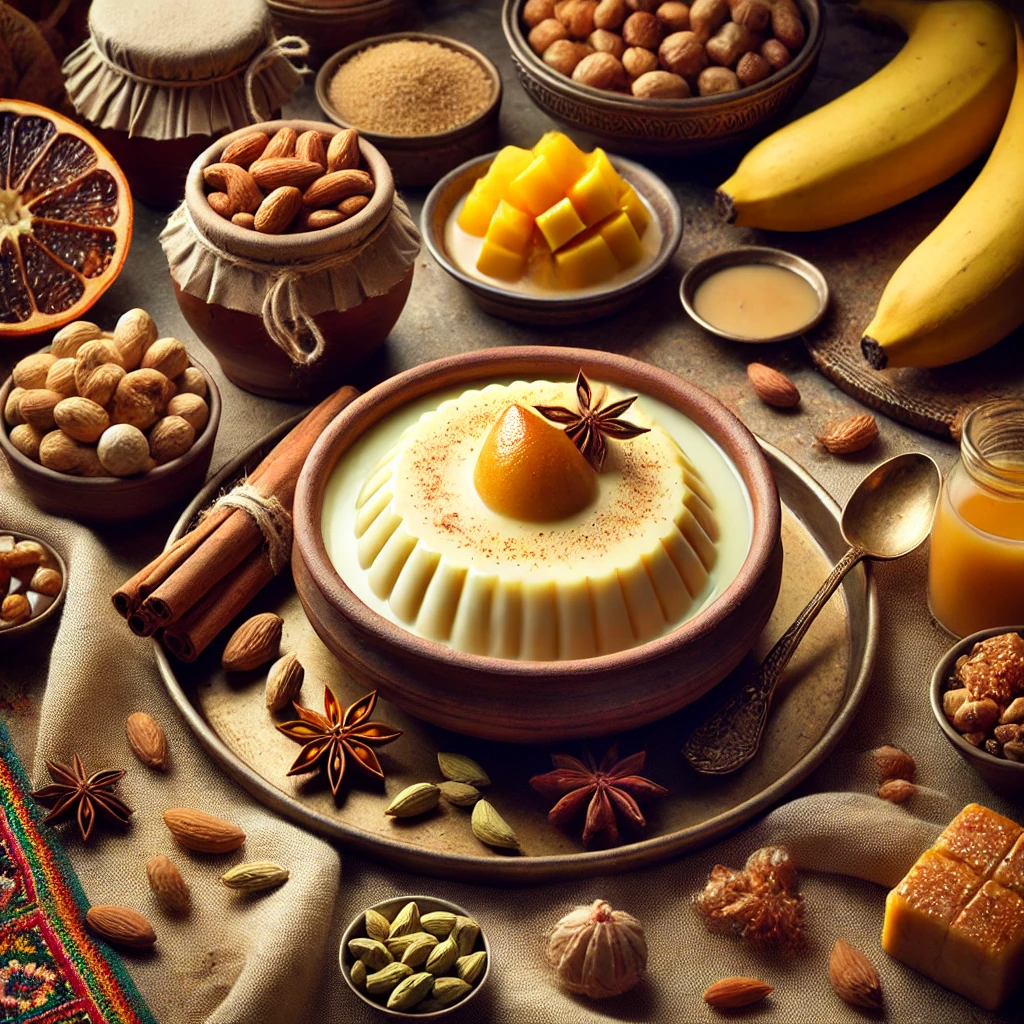Among South Asia’s vast dairy universe, Bhapa Doi from Bangladesh holds a special place. Sweet, custard-like, creamy, and deeply comforting, Bhapa Doi is technically not just a dessert—it is also a cheese-based steamed delicacy crafted from thickened yogurt and milk solids. Its taste lies somewhere between cheesecake, rabri, and traditional mishti doi, yet its technique sets it apart.
While mishti doi is fermented and clay-pot matured, Bhapa Doi is steamed, giving it a velvet interior, gentle sweetness, and a structure that resembles soft-set cheese. Its rising popularity across Bangladesh’s celebrations, household kitchens, and modern dessert cafés proves that simple ingredients can yield luxurious textures.
🧀 What Is Bhapa Doi Exactly?
Bhapa Doi translates to “steamed yogurt/steamed curd”. Though many know it as a dessert, its base composition—strained curd, sweetened milk, and gentle steaming—brings it closer to a fresh cheese custard.
Key Profile
| Attribute | Description |
|---|---|
| Category | steamed dairy cheese dessert |
| Texture | dense, creamy, custard-like |
| Flavor | aromatic, sweet, caramel-note finish |
| Key Ingredients | hung curd, condensed milk, evaporated milk |
| Technique | steaming instead of baking |
| Cultural Identity | Bengali-Muslim & Bengali-Hindu festive sweet |
The steaming locks curd proteins, creating a set cheese texture without brining, aging, or rennet.
🌍 Origins in Bengal Cuisine
Bhapa Doi has strong ties to:
-
Bangladesh (Dhaka, Mymensingh, Rangpur, Chattogram, Sylhet)
-
West Bengal traditions (in cultural overlap)
Historically, Bengali dessert culture has always been rich in:
-
milk curds
-
jaggery sweets
-
earthen matkas (clay pots)
-
steamed puddings
But Bhapa Doi marks a bridge between:
-
the simplicity of homemade yogurt
-
the richness of clarified milk desserts
This steamed curd represents rural dairy skill meeting urban sweet craft.
🥛 How Bhapa Doi Is Made (Traditional Method)
Unlike baked cheesecake, Bhapa Doi requires no oven, only steam.
Production Steps
-
Fresh curd is hung in cloth to remove whey.
-
Condensed milk + evaporated milk + sometimes jaggery are mixed.
-
Flavoring with cardamom, saffron, or rose essence.
-
Smooth whisking to eliminate bubbles.
-
Pouring into clay bowls or steel ramekins.
-
Steaming in closed vessel until set like pudding.
-
Chilling before serving for best texture.
Why Clay Pots?
Clay:
-
absorbs moisture
-
concentrates flavor
-
cools naturally
-
preserves curd aroma
🧂 Taste & Texture
Bhapa Doi is celebrated for its clean dairy sweetness and melt-in-mouth silkiness.
Flavor Notes
-
lightly caramelized from condensed milk
-
delicate tang of curd
-
floral hints if saffron or rose is used
-
richer than yogurt, lighter than cheesecake
Texture Notes
-
soft-set custard
-
spoonable but slice-capable
-
smooth with no granular curd breakup
🍽 Serving Traditions
Bhapa Doi is served:
-
at Eid feasts
-
wedding nazir plates
-
Pohela Boishakh celebrations
-
birthdays & urban dessert menus
Common Garnishes
| Garnish | Effect |
|---|---|
| chopped pistachios | crunch & color |
| slivered almonds | nut aroma |
| saffron threads | luxury finish |
| rose petals | romantic flavor |
| nolen gur (date palm jaggery) | winter caramel aroma |
With date palm jaggery, it becomes winter-special Gurer Bhapa Doi.
🥂 Modern Culinary Pairings
Fusion Ideas
-
Bhapa Doi mousse cups
-
Bhapa Doi cheesecake bars
-
Bhapa Doi with mango purée (summer special)
-
Bhapa Doi milk cake trifle
Drinks That Pair Well
| Beverage | Why |
|---|---|
| masala chai | spice cuts sweetness |
| chilled milk | enhances cream mouthfeel |
| saffron tea | fragrance harmony |
| iced coffee | sweet-bitter contrast |
🌍 Comparison with Similar Dairy Desserts
| Dessert | Similarity | Difference |
|---|---|---|
| Mishti doi | curd-based | fermented, not steamed |
| Rasmalai | milk + curd notes | soaked, not solid set |
| Cheesecake | creamy texture | baked & cheese-based |
| Flan | custard-like | egg-based, caramel top |
| Kulfi | creamy final taste | frozen, denser |
Bhapa Doi stands alone in its steam-set dairy identity.
🧊 Storage & Shelf Life
Because Bhapa Doi is high-moisture and dairy-rich:
-
do not store warm
-
avoid repeated temperature shifts
Shelf Life Guide
| Condition | Duration |
|---|---|
| refrigerated, covered | 3–4 days |
| clay pot sealed | 2–3 days |
| room temperature | unsafe after a few hours in Bangladesh climate |
Tips
-
chill before serving
-
avoid freezing (texture becomes grainy)
🌱 Nutritional Notes
| Nutrient Benefit | Explanation |
|---|---|
| calcium | dairy origins |
| probiotics | curd bacteria remain active |
| protein | strained yogurt base |
| energy | condensed milk richness |
Best consumed in moderation due to sugar concentration.
⭐ Conclusion
Bhapa Doi captures the Bangladeshi approach to dairy: minimalist ingredients, maximum flavor. Steamed rather than baked, sweet but not overwhelming, creamy but not heavy, it is the quiet star of Bengali desserts.
It honors:
-
grandmother kitchen heritage
-
clay pot cooling science
-
simplicity of fresh curd
-
tropical dairy creativity
In global dessert conversations, Bhapa Doi deserves recognition as a cheese-based cultural specialty—soft, comforting, and unmistakably Bengali.
FAQs – Bhapa Doi Cheese
1. Is Bhapa Doi a cheese or yogurt?
It is a steamed, curd-based dairy similar to fresh cheese in texture, though culturally called sweet yogurt.
2. What makes Bhapa Doi different from mishti doi?
It is steamed, not fermented and matured in clay.
3. Does Bhapa Doi require an oven?
No, only steaming in a pot or steamer.
4. Can jaggery be used instead of sugar?
Yes—gurer Bhapa Doi is a beloved winter variation.
5. How long can Bhapa Doi be stored?
Up to 3–4 days chilled, never warm.



